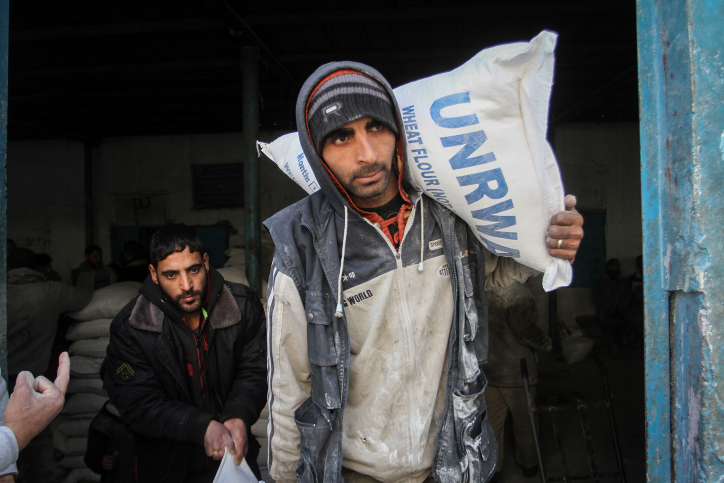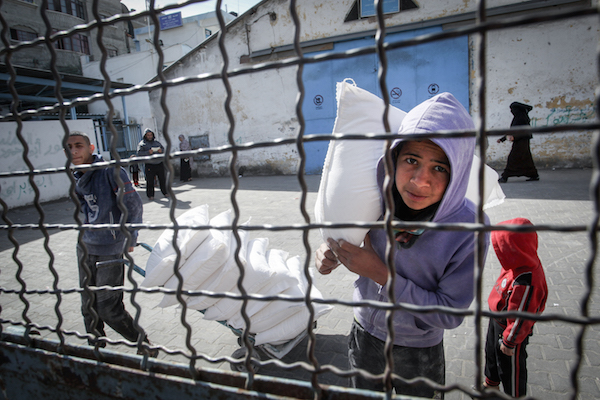Keeping Gaza on the verge of collapse keeps international humanitarian aid money flowing to exactly where it benefits Israeli interests.
By Shir Hever

“The Gaza Strip is on the brink of a humanitarian crisis.” Sound familiar? We’ve been hearing about the imminent collapse of Gaza’s drinking water, sewage, health, and electricity systems since the outbreak of the Second Intifada 18 years ago.
In their book “The One State Condition,” Ariella Azoulay and Adi Ophir attempt to answer the question, what interest does Israel have in keeping Gaza on the verge of collapse? Their answer remains valid even after fifteen years: keeping the Palestinians perpetually on the brink is proof of Israel’s conclusive victory. The Palestinians cannot take their lives as given, for Israel can take their lives at any time. This is the basis of Israel’s relation of clear relation of dominance over the Palestinians.
But while this answer is true, it is not sufficient. There is also an economic answer. As long as Gaza remains on the brink of collapse, international donors keep the flow of humanitarian aid money going. If the crisis were ended and the siege lifted, it is safe to assume that that the international donors would change the type of aid they provide and return to focus on the development of the Gazan economy (as they did from 1994—2000, until the outbreak of the Second Intifada). This type of aid would likely compete with certain branches of Israeli companies and therefore threaten the Israeli economy. Keeping Gaza on the verge of collapse keeps international humanitarian aid money flowing exactly to where it benefits Israeli interests.
In light of the growing strength of the populist right, which portrays Palestinians as total enemies of the state of Israel, we must ask why the Israeli government has refused its second opportunity to exit the situation of “the brink” — to prompt an even worse humanitarian crisis, and cause mass death in Gaza and in the occupied territory more generally. Despite the ever-deepening national hatred for the Palestinians, the Israeli government has clearly acted to prevent this kind of scenario, allowing emergency deliveries of medicine and desalination machines (internationally funded) to prevent mass death in Gaza. But why?
Despite numerous protests from the Palestinian side, the Paris Agreements signed in 1994 continue to constitute the framework for the main economic agreements between Israel and the Palestinian Authority, including the Gaza Strip. Israel controls the customs regime, thus there is no import duty on goods imported from Israel to the occupied territories, while there is on goods imported from abroad.
International aid organizations are required to provide humanitarian aid in the most efficient way possible. They must purchase the cheapest food available to aid the greatest number of people within their budget. Though food is cheaper in Jordan and Egypt, food imports from Jordan and Egypt to the occupied Palestinian territory are taxed. The taxes, in principle, go to the PA coffers, but this cannot be a consideration for the aid organizations. Instead, they are required to purchase most of the goods they distribute from Israeli companies, unless importation from another country, including import taxes, will still be cheaper than the price in Israel.
Additionally, Israeli security regulations require aid organizations to use Israeli transportation companies and vehicles, since Palestinian companies are not allowed to enter Israel to pick up goods from airports or sea-ports. Even more significant is the fact that the Palestinians do not have their own currency or central bank: financial assistance must be given in New Israeli Shekels. The foreign currency remains in the Bank of Israel, and Israeli commercial banks collect numerous service charges along the way.
What this means, in fact, is that Israel exports the occupation: as long as the international community is willing to contribute financially to prevent a humanitarian crisis in Gaza, Israeli companies continue to supply them with goods and services and receive payment in foreign currency.

In a study I conducted for the Palestinian organization Aid Watch in 2015, I observed the correlation between international aid, on the one hand, and the trade deficit in goods and services between the Palestinian and Israeli economies, on the other. The data for the study was from 2000-2013. I found that some 78 percent of aid to the Palestinians found its way to the Israeli economy. This is a rough estimate, to be sure. And we need to remember that this isn’t simply clean profit for Israel companies but revenue. The Israeli companies need to provide goods and services for the money and bear the costs of production.
In light of these figures, it’s easy to understand the gap between the government’s populist declarations against the Palestinians and the steps it quietly but consistently takes to increase international humanitarian aid to the Palestinians. During an emergency meeting of contributing countries in January, Regional Cooperation Minister Tzahi Hanegbi presented a billion-dollar plan to rebuild the Gaza Strip — foreign funded, of course. Transportation Minister Yisrael Katz’s plan to build an artificial island off the Gaza coast also suggested that foreign funders bear some of the cost of the occupation, bringing foreign cash into Israeli coffers, and, at the same time, preventing the situation in Gaza from deteriorating to the point of no-return.
The picture I’ve presented here is not new. It is clear to the contributing countries, the international aid organizations, the Israeli army, and the Israeli government. It is, of course, clear to the Palestinians, who need the aid but who also understand that it makes the work of occupation easier for the Israeli authorities.
However, there is also a serious problem with this picture. It presupposes the existence of a state called “the brink” of humanitarian crisis and generates endless discussion of whether the current state of affairs constitutes a crisis or not. But when exactly do the economic conditions in Gaza constitute a humanitarian crisis? How many people need to die before the siege is lifted to avoid reaching the point, beyond which mass starvation, disease and the disintegration of the social fabric cannot be stopped?
The most important recent aid initiative to move beyond this situation is the flotilla initiative. The flotillas provide aid to Palestinians in coordination with Gaza residents’ specific demands for goods that are not permitted to cross through Kerem Shalom. Without using Israeli currency and without paying customs duties to the Israeli treasury, the boats attempt to provide the aid directly, without a middle-man. Unsurprisingly, the Israeli response has been violent – the army killed nine activists on the Mavi Marmara ship in May 2010.
But what would the Israeli government do if the major international aid organizations adopted a similar mode of action to supply the Palestinians with aid directly, without using Israeli companies and without paying taxes to the Israeli authorities? This strategy would expose the economic interest Israel has in keeping Gaza on “the brink” and would force the Israeli government to choose: take direct control over the lives of the Palestinians and pay the costs involved, or allow the international humanitarian organizations to supply aid under the conditions of their choosing, therefore helping the Palestinians out of the crisis.
This would not abrogate Israel’s responsibility for the Palestinians — which is delineated by international law — but it would eliminate Israel’s financial incentive to maintain the occupation and the siege of Gaza.
Shir Hever is an economic researcher and journalist living in Heidelberg, Germany. His latest book, The Privatisation of Israeli Security, was published by Pluto Press in 2017. A version of this article first appeared in Hebrew at Local Call. Read it here.
